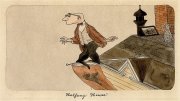In 1968, Lucy Moore '66 accompanied her then-husband, Bob Hilgendorf, J.D. '67, to Chinle--Canyon de Chelly--in the heart of the Navajo Nation, in Arizona, hoping not only to do some good but also "to take a look around and understand better who makes up this country." Once there, she found herself learning as much about her own identity as about her new community. In her first book, Into the Canyon, written more than 30 years later, Moore describes the seven years she spent working in Navajo country, learning about Diné culture and what it meant to be Anglo in that context, and forging lasting friendships. Her husband had been hired by Diné Bee'iiná' Náhiilnah Bee Agha'diit'aahe Inc. (DNA), a start-up that provided legal assistance in civil cases for residents who could not afford lawyers. Moore taught in elementary schools before being elected justice of the peace for her district.
 |
| Lucy Moore, her son, and then-husband in front of their cabin in 1972 |
| From the book |
Four years of undergraduate activism and two as a social worker in inner-city Boston did not fully prepare Moore for the challenges of Chinle. In addition to driving through quicksand, scaling canyon walls, and surviving dust storms, she was initially perplexed by certain Diné behavior--the limp handshake, insensitivity toward animals, and ready toleration of silence when there was nothing important to say. But her attitude soon shifted. "I saw myself as loud, talking all the time, nervous about silence, somewhat luxurious in my concerns [for animals, the environment, global overpopulation, for example]. I realized that I was extremely privileged, like most Anglos, and unaware of it," she notes now.
One week, a few months after moving to Chinle, she began to notice certain physical symptoms: her skin looked too yellow, her eyes too pale. As she was preparing to go to the doctor, she realized, "I wasn't sick--I was just white," unlike 99 percent of her neighbors. "I learned at a deep emotional level what it is like to be a minority," Moore says, "to feel wrong in looks, in language, in customs, to not know the rules the majority are playing by."
News of increasingly violent antiwar protests and of the growing women's-rights movement had a surprising effect on her. "Those protesting, bra-burning women looked like a bunch of whiners to me. I could hardly see them as oppressed when I was in the middle of a culture which was oppressed almost out of existence," she says of her feelings then. Widespread efforts by the Navajo to adopt Anglo ways at first seemed a disturbing effect of this oppression. When Moore worked at a local primary school, she struggled with her colleagues' assumption that nativity plays, Easter egg hunts, and nursery rhymes should be part of the curriculum. She learned, however, that many Navajo parents wanted their children to become familiar with Anglo culture so they might eventually succeed in the outside world.
And she "gradually learned that it was just fine to be Anglo...that Navajos didn't seem to care as much about that as I did. They were more interested in who I was--was I smart, did I have something to offer, did I have a sense of humor, was I willing to learn about their culture, did I seem like a nice person?" Moore reports. "I learned from them that those human elements are much more important than the color of my skin; ironically, something I thought I already knew, but didn't."
Although Moore left Chinle long ago, her continuing ties to the Navajo and interest in Native American rights have led to her current career. For the past 20 years, she has worked as a mediator in Santa Fe, specializing in natural-resource and tribal issues such as noise pollution, water rights, and school regulations. Mediation, she says, allows acknowledging the complexities of interactions between different cultures and subcultures. "Most importantly, I have learned not to make assumptions about anyone or anything," she explains. "In Chinle, I learned that there are a million shades of gray."
~Emer Vaughn





